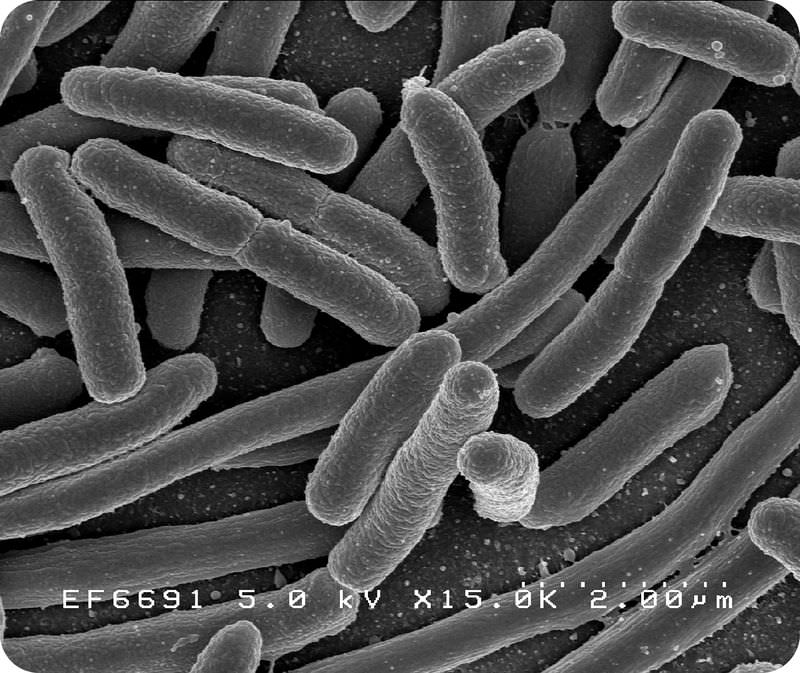5.3 细菌营养
章节大纲
-
Can bacteria make their own food from sunlight?
::细菌能用阳光做自己的食物吗?Plants aren't the only organisms that use the energy of the sun to make food. Some bacteria can also perform . In fact, the first photosynthetic organisms on Earth were bacteria. Photosynthesis is just one of many ways that bacteria can obtain energy.
::植物并不是利用太阳能量生产食物的唯一生物体。有些细菌也可以发挥作用。事实上,地球上最早的光合作生物是细菌。光合作用只是细菌获得能量的许多方法之一。Bacteria Nutrition
::细菌营养Like all organisms, bacteria need energy, and they can acquire this energy through a number of different ways.
::像所有生物一样,细菌需要能量, 它们可以通过多种不同的方式获得这种能量。Photosynthesis
::光合作用Photosynthetic bacteria use the energy of the sun to make their own food. In the presence of sunlight, carbon dioxide and water are turned into glucose and oxygen. The glucose is then turned into usable energy. Glucose is like the "food" for the bacteria. An example of photosynthetic bacteria is cyanobacteria , as seen in the opening image. These bacteria are sometimes called blue-green , although they are not algae, due to their numerous chlorophyll molecules.
::光合作细菌利用太阳的能量制造自己的食物。 在阳光下, 二氧化碳和水会变成葡萄糖和氧气。 然后葡萄糖会变成可用的能量。 葡萄糖就像细菌的“食物 ” 。 光合作细菌的一个例子就是氰化细菌。 这些细菌有时被称为蓝绿色, 尽管它们不是藻类, 因为它们有很多叶绿分子。Decomposers
::混解器Bacteria known as decomposers break down wastes and dead organisms into smaller molecules. These bacteria use the organic substrates they break down to get their energy, carbon, and nutrients they need for survival.
::这些细菌利用有机基质获得生存所需的能量、碳和养分。Chemotrophs
::润滑油Bacteria can also be chemotrophs . Chemosynthetic bacteria, or chemotrophs , obtain energy by breaking down chemical compounds in their environment. An example of one of these chemicals broken down by bacteria is nitrogen-containing ammonia. These bacteria are important because they help cycle nitrogen through the environment for other living things to use. Nitrogen cannot be made by living organisms, so it must be continually recycled. Organisms need nitrogen to make , such as .
::细菌也可以是化肥细菌。化学合成细菌或化肥细菌通过在环境中分解化学化合物获得能量。这些化学物质中一种被细菌分解为含氮氨的例子。这些细菌很重要,因为它们有助于在环境中循环氮,供其他生物使用。氮不能由活生物体制造,因此必须不断回收。有机体需要氮来制造,例如 。Mutualism
::相互互助Some bacteria depend on other organisms for survival. For example, some bacteria live in the roots of legumes, such as ( Figure ). The bacteria turn nitrogen-containing molecules into nitrogen that the plant can use. Meanwhile, the root provides nutrients to the bacteria. In this relationship, both the bacteria and the plant benefit, also known as mutualism .
::有些细菌依靠其他生物来生存。例如,有些细菌生活在豆类的根部,例如(图 ) 。细菌把含氮分子变成植物可以使用的氮。与此同时,根部为细菌提供养分。在这种关系中,细菌和植物的利益都被称为相互性。Other mutualistic bacteria include gut microbes. These are bacteria that live in the intestines of animals . They are usually beneficial bacteria, needed by the host organism. These microbes obviously don't kill their host, as that would kill the bacteria as well.
::其它相互性细菌包括肠道微生物。 这些细菌生活在动物肠中的细菌。 它们通常都是有用的细菌,是宿主生物所需要的。 这些微生物显然不会杀死宿主,因为这也会杀死细菌。These mutualistic bacteria-containing nodules on a soybean root help provide the plant with nitrogen.
::这些在大豆根上含有共生细菌的结核有助于给植物提供氮。Parasitism
::排他性Other bacteria are parasitic and can cause illness. In parasitism , the bacteria benefit, and the other organism is harmed. Harmful bacteria will be discussed in another concept.
::其他细菌是寄生虫,可致病。在寄生虫炎中,细菌和其他生物体都受到了伤害。 有害细菌将在另一个概念中讨论。Summary
::摘要-
Bacteria can obtain energy and nutrients by performing photosynthesis, decomposing dead organisms and wastes, or breaking down chemical compounds.
::细菌可以通过光合作用、分解死亡生物和废物或打破化学化合物获得能量和养分。 -
Bacteria can obtain energy and nutrients by establishing close relationships with other organisms, including mutualistic and parasitic relationships.
::细菌可以与其他生物建立密切关系,包括相互关系和寄生虫关系,从而获得能量和养分。
Explore More
::探索更多Use the resources below to answer the questions that follow.
::利用以下资源回答以下问题。Explore More I
::探索更多-
Bacteria
(11:04)
::细菌(11:04)
-
What are the three nutritional types of bacteria?
::三种营养类型的细菌是什么? -
What is the base energy source for these three types?
::这三类能源的基本能源来源是什么? -
Give an example of a photoautotroph.
::举个例子 举个光自足的例子
Explore More II
::探索更多情况二-
Bacteria: Life History and Ecology
::生物历史和生态学
-
What is the difference between a heterotroph and an autotroph?
::血化与自养有什么区别? -
What is the difference between aerobic, anaerobic, and facultative anaerobic bacteria?
::有氧、厌氧和自学厌氧细菌之间有什么区别? -
What are two ways bacteria play important roles in the ecosystem?
::细菌在生态系统中以什么两种方式发挥重要作用?
Review
::回顾-
Describe two ways that bacteria obtain nutrients and energy?
::描述细菌获得养分和能量的两种方式? -
What is an example of a mutualism with a bacteria?
::什么是细菌互助的范例? -
What is an example of a photosynthetic bacteria.
::什么是光合细菌的例子。 -
Describe the importance of chemosynthetic bacteria.
::说明化学合成细菌的重要性。
-
Bacteria can obtain energy and nutrients by performing photosynthesis, decomposing dead organisms and wastes, or breaking down chemical compounds.

